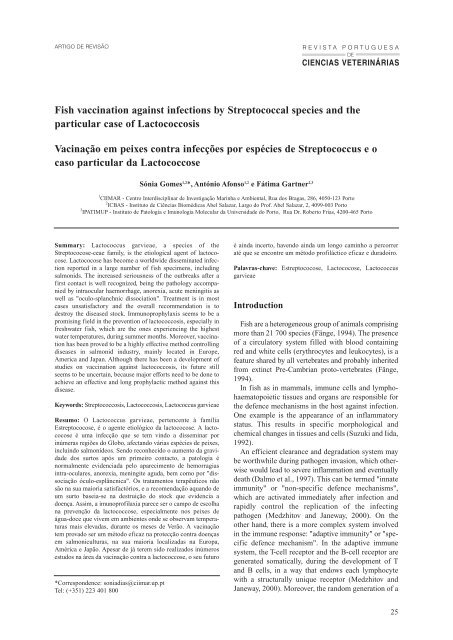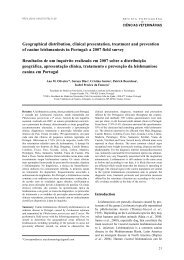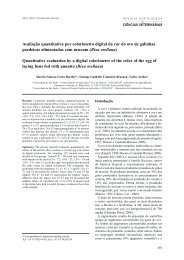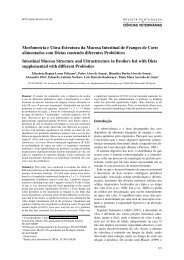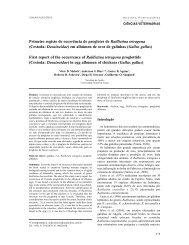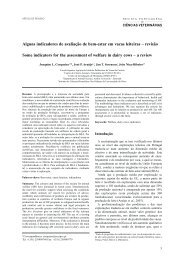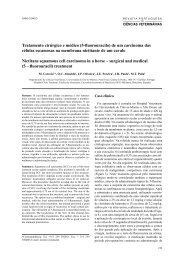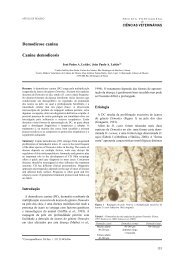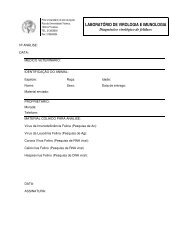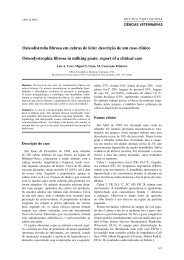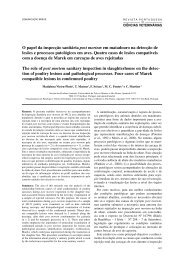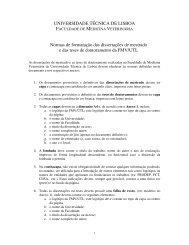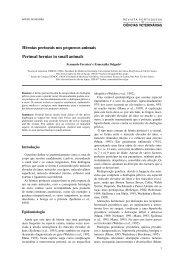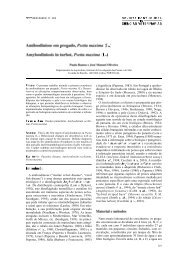Fish vaccination against infections by Streptococcal species and the ...
Fish vaccination against infections by Streptococcal species and the ...
Fish vaccination against infections by Streptococcal species and the ...
Create successful ePaper yourself
Turn your PDF publications into a flip-book with our unique Google optimized e-Paper software.
ARTIGO DE REVISÃO<br />
REVISTA PORTUGUESA<br />
DE<br />
CIÊNCIAS VETERINÁRIAS<br />
<strong>Fish</strong> <strong>vaccination</strong> <strong>against</strong> <strong>infections</strong> <strong>by</strong> <strong>Streptococcal</strong> <strong>species</strong> <strong>and</strong> <strong>the</strong><br />
particular case of Lactococcosis<br />
Vacinação em peixes contra infecções por espécies de Streptococcus e o<br />
caso particular da Lactococcose<br />
Sónia Gomes 1,2 *, António Afonso 1,2 e Fátima Gartner 2,3<br />
1 CIIMAR - Centro Interdisciplinar de Investigação Marinha e Ambiental, Rua dos Bragas, 286, 4050-123 Porto<br />
2 ICBAS - Instituto de Ciências Biomédicas Abel Salazar, Largo do Prof. Abel Salazar, 2, 4099-003 Porto<br />
3 IPATIMUP - Instituto de Patologia e Imunologia Molecular da Universidade do Porto, Rua Dr. Roberto Frias, 4200-465 Porto<br />
Summary: Lactococcus garvieae, a <strong>species</strong> of <strong>the</strong><br />
Streptococose-ceae family, is <strong>the</strong> etiological agent of lactococose.<br />
Lactococose has become a worldwide disseminated infection<br />
reported in a large number of fish specimens, including<br />
salmonids. The increased seriousness of <strong>the</strong> outbreaks after a<br />
first contact is well recognized, being <strong>the</strong> pathology accompanied<br />
<strong>by</strong> intraocular haemorrhage, anorexia, acute meningitis as<br />
well as "oculo-splanchnic dissociation". Treatment is in most<br />
cases unsatisfactory <strong>and</strong> <strong>the</strong> overall recommendation is to<br />
destroy <strong>the</strong> diseased stock. Immunoprophylaxis seems to be a<br />
promising field in <strong>the</strong> prevention of lactococcosis, especially in<br />
freshwater fish, which are <strong>the</strong> ones experiencing <strong>the</strong> highest<br />
water temperatures, during summer months. Moreover, <strong>vaccination</strong><br />
has been proved to be a highly effective method controlling<br />
diseases in salmonid industry, mainly located in Europe,<br />
America <strong>and</strong> Japan. Although <strong>the</strong>re has been a development of<br />
studies on <strong>vaccination</strong> <strong>against</strong> lactococcosis, its future still<br />
seems to be uncertain, because major efforts need to be done to<br />
achieve an effective <strong>and</strong> long prophylactic method <strong>against</strong> this<br />
disease.<br />
Keywords: Streptococcosis, Lactococcosis, Lactococcus garvieae<br />
Resumo: O Lactococcus garvieae, pertencente à família<br />
Estreptococose, é o agente etiológico da lactococose. A lactococose<br />
é uma infecção que se tem vindo a disseminar por<br />
inúmeras regiões do Globo, afect<strong>and</strong>o várias espécies de peixes,<br />
incluindo salmonídeos. Sendo reconhecido o aumento da gravidade<br />
dos surtos após um primeiro contacto, a patologia é<br />
normalmente evidenciada pelo aparecimento de hemorragias<br />
intra-oculares, anorexia, meningite aguda, bem como por "dissociação<br />
óculo-esplâncnica". Os tratamentos terapêuticos não<br />
são na sua maioria satisfactórios, e a recomendação aqu<strong>and</strong>o de<br />
um surto baseia-se na destruição do stock que evidencia a<br />
doença. Assim, a imunoprofilaxia parece ser o campo de escolha<br />
na prevenção da lactococcose, especialmente nos peixes de<br />
água-doce que vivem em ambientes onde se observam temperaturas<br />
mais elevadas, durante os meses de Verão. A vacinação<br />
tem provado ser um método eficaz na protecção contra doenças<br />
em salmoniculturas, na sua maioria localizadas na Europa,<br />
América e Japão. Apesar de já terem sido realizados inúmeros<br />
estudos na área da vacinação contra a lactococcose, o seu futuro<br />
*Correspondence: soniadias@ciimar.up.pt<br />
Tel: (+351) 223 401 800<br />
é ainda incerto, havendo ainda um longo caminho a percorrer<br />
até que se encontre um método profiláctico eficaz e duradoiro.<br />
Palavras-chave: Estreptococose, Lactococose, Lactococcus<br />
garvieae<br />
Introduction<br />
<strong>Fish</strong> are a heterogeneous group of animals comprising<br />
more than 21 700 <strong>species</strong> (Fänge, 1994). The presence<br />
of a circulatory system filled with blood containing<br />
red <strong>and</strong> white cells (erythrocytes <strong>and</strong> leukocytes), is a<br />
feature shared <strong>by</strong> all vertebrates <strong>and</strong> probably inherited<br />
from extinct Pre-Cambrian proto-vertebrates (Fänge,<br />
1994).<br />
In fish as in mammals, immune cells <strong>and</strong> lymphohaematopoietic<br />
tissues <strong>and</strong> organs are responsible for<br />
<strong>the</strong> defence mechanisms in <strong>the</strong> host <strong>against</strong> infection.<br />
One example is <strong>the</strong> appearance of an inflammatory<br />
status. This results in specific morphological <strong>and</strong><br />
chemical changes in tissues <strong>and</strong> cells (Suzuki <strong>and</strong> Iida,<br />
1992).<br />
An efficient clearance <strong>and</strong> degradation system may<br />
be worthwhile during pathogen invasion, which o<strong>the</strong>rwise<br />
would lead to severe inflammation <strong>and</strong> eventually<br />
death (Dalmo et al., 1997). This can be termed "innate<br />
immunity" or "non-specific defence mechanisms",<br />
which are activated immediately after infection <strong>and</strong><br />
rapidly control <strong>the</strong> replication of <strong>the</strong> infecting<br />
pathogen (Medzhitov <strong>and</strong> Janeway, 2000). On <strong>the</strong><br />
o<strong>the</strong>r h<strong>and</strong>, <strong>the</strong>re is a more complex system involved<br />
in <strong>the</strong> immune response: "adaptive immunity" or "specific<br />
defence mechanism". In <strong>the</strong> adaptive immune<br />
system, <strong>the</strong> T-cell receptor <strong>and</strong> <strong>the</strong> B-cell receptor are<br />
generated somatically, during <strong>the</strong> development of T<br />
<strong>and</strong> B cells, in a way that endows each lymphocyte<br />
with a structurally unique receptor (Medzhitov <strong>and</strong><br />
Janeway, 2000). Moreover, <strong>the</strong> r<strong>and</strong>om generation of a<br />
25
Gomes S e Afonso A<br />
highly diverse repertoire of antigen receptors allows<br />
<strong>the</strong> adaptive immune system to recognize virtually any<br />
antigen (Medzhitov <strong>and</strong> Janeway, 2000).<br />
Prophylactic methods <strong>against</strong> fish diseases<br />
During <strong>the</strong> last decades, <strong>the</strong>re has been a continuous<br />
growth of aquaculture industry all over <strong>the</strong> world<br />
(Hastein, 1995). The most significant growth has been<br />
seen in carp production as well as in <strong>the</strong> production of<br />
o<strong>the</strong>r cyprinids <strong>and</strong> even more so for carnivorous fish<br />
<strong>species</strong> such as salmonids, which are farmed in intensive<br />
conditions (Gudding et al., 1999). However, any<br />
intensive bioproduction – whe<strong>the</strong>r on l<strong>and</strong> or at sea –<br />
will experience disease problems (Hastein, 1995).<br />
Infectious diseases that occur as sporadic events in<br />
wild fish populations may cause high mortalitities<br />
when appearing in intensive fish farming (Gudding et<br />
al., 1999). For <strong>the</strong> aquaculture industry to prosper in<br />
<strong>the</strong> future it is a prerequisite that <strong>the</strong> losses caused <strong>by</strong><br />
diseases <strong>and</strong> <strong>the</strong> use of antibiotics are kept to a minimum.<br />
Immunoprophylaxis recognized <strong>by</strong> stimulation<br />
of non-specific <strong>and</strong> specific immunity is consequently<br />
<strong>the</strong> method adopted for developing aquaculture into a<br />
sustainable bioproduction in <strong>the</strong> aquatic ecosystems.<br />
<strong>Fish</strong> can be immunized in three ways: <strong>by</strong> injection<br />
preferably intraperitoneally, <strong>by</strong> immersion, usually <strong>by</strong><br />
dipping <strong>the</strong> fish in a diluted vaccine solution, or <strong>by</strong><br />
oral administration along with food. These methods<br />
have different advantages <strong>and</strong> disadvantages with<br />
respect to <strong>the</strong> level of protection, side effects, practicability<br />
<strong>and</strong> cost-efficiency. Injection <strong>and</strong> immersion<br />
are <strong>the</strong> two major methods that have been developed<br />
for use at an industrial scale <strong>and</strong> in commercial production<br />
of salmonids <strong>and</strong> both <strong>vaccination</strong> procedures<br />
are established practices <strong>and</strong> integrated as part of <strong>the</strong><br />
production routines.<br />
There is still a limited underst<strong>and</strong>ing of <strong>the</strong> mechanisms<br />
involved in antigen uptake <strong>and</strong> presentation after<br />
immersion <strong>and</strong> oral <strong>vaccination</strong> (Nakanishi <strong>and</strong> Ototake,<br />
1997; Quentel <strong>and</strong> Vigneulle, 1997; Moore et al., 1998).<br />
Even so, <strong>the</strong> first encounter with pathogens occurs<br />
through <strong>the</strong> mucosal surfaces <strong>and</strong> <strong>the</strong> indisputable presence<br />
of a mucosal associated immune system makes antigen<br />
delivery through <strong>the</strong> mucosal surfaces a viable approach.<br />
The mucosal immunity of fish is still a poorly explored<br />
field of research, although indications are available for<br />
<strong>the</strong> existence of this type of immunity (Rombout <strong>and</strong><br />
Joosten, 1992). Especially for fish living in a pathogen-<br />
-rich aquatic environment, <strong>the</strong> existence of a mucosal<br />
immune system may be very important. In fact, compared<br />
with higher vertebrates fish have <strong>the</strong>ir skin as an<br />
extra mucosal barrier. However, an important criterion<br />
for <strong>the</strong> existence of a mucosal immune system is <strong>the</strong><br />
secretion of antigen-specific antibodies at mucosal surfaces<br />
(Rombout <strong>and</strong> Joosten, 1992).<br />
Oral <strong>vaccination</strong> research has so far focused on protecting<br />
<strong>the</strong> antigen from digestion <strong>and</strong> decomposition<br />
26<br />
during passage through <strong>the</strong> stomach <strong>and</strong> anterior part<br />
of <strong>the</strong> gut. The ultimate goal has been to stimulate <strong>the</strong><br />
immunocompetent tissues in <strong>the</strong> posterior part of <strong>the</strong><br />
intestine. Different approaches have been tried, one of<br />
<strong>the</strong> latest using antigens encapsulation in alginate <strong>and</strong><br />
liposome microcapsules (Joosten et al., 1997).<br />
The optimal way of developing an effective vaccine<br />
entails <strong>the</strong> identification of <strong>the</strong> pathogens’ key virulence<br />
factors. Fur<strong>the</strong>r, <strong>the</strong> induction of <strong>the</strong> immune<br />
response must be optimized so that <strong>the</strong> vaccinated animal<br />
develops a protective immunity <strong>against</strong> <strong>the</strong><br />
pathogen (Gudding et al., 1999).<br />
Vaccines <strong>and</strong> adjuvants<br />
RPCV (2006) 101 (557-558) 25-35<br />
Inactivated vaccines (bacterins)<br />
A common approach in vaccine production is to<br />
inactivate <strong>the</strong> pathogen <strong>and</strong> toxins <strong>by</strong> physical (e.g.<br />
UV <strong>and</strong> heat) or <strong>by</strong> chemical (e.g. kill <strong>by</strong> formol)<br />
means so that it is no longer capable of replication in<br />
or damaging <strong>the</strong> host. It is critically important to<br />
maintain <strong>the</strong> structure of epitopes on antigens during<br />
inactivation. Administration of <strong>the</strong>se bacterins is done<br />
<strong>by</strong> injection or immersion. Provided that <strong>the</strong> serotypes<br />
used for vaccine preparation cover <strong>the</strong> field of virulent<br />
strains <strong>and</strong> that <strong>the</strong> vaccines are used correctly, <strong>the</strong>se<br />
vaccines are usually effective <strong>and</strong> give negligible side<br />
effects (Stevenson, 1997; Toranzo et al., 1997). Most<br />
vaccines used in aquaculture to date have been inactivated,<br />
bacterial vaccines (Gudding et al., 1999).<br />
Live vaccines<br />
Live, attenuated vaccines should potentially have<br />
many advantages in aquaculture (Benmansour <strong>and</strong> de<br />
Kinkelin, 1997). Vaccination with a live vaccine is in<br />
reality an infection (with an attenuated strain), <strong>and</strong> if<br />
vaccinated fish sheds <strong>the</strong> vaccine strain, an effective<br />
dissemination of <strong>the</strong> antigen in <strong>the</strong> production would<br />
take place over an extended time period. Live vaccines<br />
also have <strong>the</strong> advantage of stimulating <strong>the</strong> cellular<br />
branch of <strong>the</strong> immune system (Marsden et al., 1996).<br />
Finally, attenuated vaccines have some economical<br />
advantages in terms of simple delivery <strong>and</strong> low dose<br />
requirements due to multiplication in <strong>the</strong> fish<br />
(Gudding et al., 1999). However, <strong>the</strong> risk of reversion<br />
to virulence is still poorly understood <strong>and</strong> <strong>the</strong>re seems<br />
to be a general view that <strong>the</strong> risks associated with live<br />
vaccines in aquaculture, whe<strong>the</strong>r produced <strong>by</strong> conventional<br />
methods or <strong>by</strong> recombinant techniques should<br />
be heavily scrutinized.<br />
Vaccines based on DNA-technology<br />
In recent years, several vectors have been used for<br />
cost-effective production of sufficient quantities of<br />
protective antigens <strong>by</strong> recombinant DNA technology.
Gomes S e Afonso A<br />
In aquaculture, research on recombinant vaccines has<br />
focused on viral vaccines. Genetic immunization<br />
using naked DNA is <strong>the</strong> most recent approach in vaccine<br />
design (Babuik et al., 1996). This technology is<br />
based on <strong>the</strong> observations that skeletal muscle cells<br />
injected with purified plasmid DNA express plasmidencoded<br />
proteins. DNA vaccines have advantages<br />
over conventional vaccines. In mammals, <strong>the</strong> specific<br />
immune response after DNA <strong>vaccination</strong> encompasses<br />
antibodies, T-helper cells, as well as cytotoxic cells.<br />
However, before DNA vaccines are applied in commercial<br />
enterprises in aquaculture, safety for fish,<br />
environment <strong>and</strong> <strong>the</strong> consumer have to be addressed.<br />
As <strong>the</strong> DNA-sequence encodes only a single viral gene,<br />
<strong>the</strong>re should be no possibility of reversion to<br />
virulence, which is a critical factor in relation to environmental<br />
safety in aquaculture (Gudding et al., 1999).<br />
Adjuvants in <strong>the</strong> vaccines formulation<br />
In most vaccines for animals, adjuvants are a crucial<br />
ingredient for efficacy (Gudding et al., 1999). Briefly,<br />
<strong>the</strong>se substances will enhance <strong>the</strong> immune response in<br />
order to make antigens more effective <strong>by</strong> magnifying<br />
<strong>the</strong> immune pathways <strong>and</strong> also will be helpful increasing<br />
<strong>the</strong> action of small doses of antigens to enhance<br />
<strong>the</strong> immune response to levels that can prevent diseases<br />
in fish culture (Anderson, 1997). In salmonids, a<br />
single injection of vaccines with aluminium-based<br />
adjuvants or glucans induced an acceptable protection<br />
<strong>against</strong> furunculosis, however, <strong>the</strong> duration was relatively<br />
short (Gudding et al., 1999). In this fish group,<br />
various oil-adjuvants induced better <strong>and</strong> more longlasting<br />
protection than aluminium <strong>and</strong> glucan <strong>against</strong><br />
furunculosis in challenge <strong>and</strong> field trials (Midtlyng,<br />
1996; Midtlyng et al., 1996a; Midtlyng et al., 1996b).<br />
Oil-adjuvants are now used extensively in commercial<br />
injectable bacterins. A double-adjuvant principle combines<br />
glucans <strong>and</strong> oil-adjuvants <strong>and</strong> thus induces both<br />
short- <strong>and</strong> long-term protection (Gudding et al.,<br />
1999). Adjuvants in injectable vaccines generally create<br />
local reactions with granulomas at <strong>the</strong> injection<br />
site. The reactions may vary from mild to severe. Oiladjuvants<br />
generally create <strong>the</strong> most severe reactions<br />
(peritoneal granulomas <strong>and</strong> pigmentation) <strong>and</strong> on a<br />
few occasions <strong>the</strong>y have affected growth rate of <strong>the</strong><br />
fish as well as <strong>the</strong> quality of <strong>the</strong> final product (Poppe<br />
<strong>and</strong> Breck, 1997; Midtlyng <strong>and</strong> Lillehaug, 1998;<br />
Afonso et al., 2004). There is little doubt that<br />
immunoprophylaxis may largely reduce <strong>the</strong> risks for<br />
large scale animal suffering, caused <strong>by</strong> disease epizootics<br />
in fish farming. Side effects due to h<strong>and</strong>ling<br />
<strong>and</strong> anaes<strong>the</strong>sia, which are required to vaccinate fish<br />
<strong>by</strong> injection, can be minimized. While <strong>the</strong> use of adjuvanted<br />
vaccines may cause some undesirable side<br />
effects, <strong>the</strong>y are never<strong>the</strong>less acceptable from an animal<br />
welfare point of view, especially when taking into<br />
account <strong>the</strong> consequences of leaving <strong>the</strong> fish unpro-<br />
RPCV (2006) 101 (557-558) 25-35<br />
tected <strong>against</strong> disease. At present, <strong>the</strong> reduction of vaccine<br />
side effects <strong>by</strong> maintenance of durable immunity<br />
constitutes <strong>the</strong> presently dominant challenge for fish<br />
vaccinology (Midtlyng, 1997).<br />
The ability of fish vaccines to induce a protective<br />
immunity is for <strong>the</strong> most part based on experimental<br />
challenge studies <strong>and</strong>/or field experiments. However,<br />
<strong>the</strong> virulence mechanisms for some fish pathogens<br />
have been elucidated, <strong>and</strong> methods for studying <strong>the</strong><br />
antibody response <strong>and</strong> even <strong>the</strong> cellular response to<br />
some protective antigens have been described<br />
(Gudding et al., 1999). Consequently data have been<br />
generated to describe <strong>the</strong> relationship between specific<br />
parameters of <strong>the</strong> immune response <strong>and</strong> protection<br />
(Reitan <strong>and</strong> Secombes, 1997). The environmental temperature<br />
has an important influence on <strong>the</strong> development<br />
of immunity in fish (Gudding et al., 1999). The<br />
production of antibodies in Atlantic salmon vaccinated<br />
<strong>and</strong> reared at temperatures of 2 0 C were generally lower<br />
than in fish vaccinated at 10 0 C (Eggset et al., 1997).<br />
Once an effective vaccine has been developed on a<br />
laboratory scale, it must be scaled up for production<br />
(Ward, 1982). Regulations set up <strong>by</strong> <strong>the</strong> licensing<br />
authorities ensure that only vaccines, which are safe<br />
<strong>and</strong> effective, are launched on to <strong>the</strong> market (Ward,<br />
1982). Briefly, after an initial field-testing, developed<br />
in populations of fish, <strong>the</strong>re will be a submission for a<br />
Product License (Ward, 1982). However, when analyzing<br />
this subject on a fish farmer point of view, o<strong>the</strong>r<br />
factors are also taken into account. For <strong>the</strong> fish farmer,<br />
<strong>vaccination</strong> is a matter of economy, <strong>the</strong> use of vaccines<br />
at relatively low cost should increase profitability <strong>by</strong><br />
preventing loss of fish (Horne <strong>and</strong> Robertson, 1987).<br />
Bacteriosis caused <strong>by</strong> streptococcal<br />
<strong>species</strong><br />
Bacterial <strong>infections</strong> in aquaculture were mainly originated<br />
<strong>by</strong> Gram-negative microorganisms. However, in<br />
<strong>the</strong> last years, due to unknown reasons, <strong>infections</strong> provoked<br />
<strong>by</strong> Gram-positive bacteria have developed, being<br />
nowadays one of <strong>the</strong> main problems in <strong>the</strong> aquaculture<br />
industries (Padrós <strong>and</strong> Furones, 2002). The Gram-positive<br />
cocci are grouped toge<strong>the</strong>r based on <strong>the</strong>ir Gramstain<br />
reaction, thick cell wall composition, <strong>and</strong> spherical<br />
shape. In this review we will focus on <strong>the</strong><br />
Streptococcaceae family. Two genera of cocci are<br />
included in this family: Streptococcus <strong>and</strong> Diplococcus,<br />
being primarily differentiated on <strong>the</strong> basis of arrangement.<br />
The primary division of <strong>the</strong> Streptococcaceae<br />
into two physiological groups is based on <strong>the</strong> difference<br />
in fermentation products namely homofermentative<br />
<strong>and</strong> heterofermentative. The first is fur<strong>the</strong>r divided on<br />
<strong>the</strong> basis of solubility in surface tension reducents into<br />
<strong>the</strong> genera Diplococcus (soluble) <strong>and</strong> Streptococcus<br />
(not soluble) (Frobisher, 1954).<br />
27
Gomes S e Afonso A<br />
Streptococcosis is a bacterial disease mainly caused<br />
<strong>by</strong> streptococci, lactococci <strong>and</strong> vagococci bacteria. It<br />
occurs in both fresh <strong>and</strong> seawater <strong>and</strong> has been a source<br />
of major economic losses since <strong>the</strong> early seventies for<br />
<strong>the</strong> rainbow trout (Oncorhynchus mykiss) <strong>and</strong> marine<br />
fish industry in Asia (especially yellowtail Seriola quinqueradiata)<br />
as well as in <strong>the</strong> United States of America<br />
<strong>and</strong> South Africa. With <strong>the</strong> development of intensive<br />
fish culture practices in Japan, bacterial <strong>and</strong> viral diseases<br />
have spread <strong>and</strong> caused serious problems for culturists<br />
(Kusuda <strong>and</strong> Salati, 1993). The disease, which is associated<br />
with high water temperatures, is now becoming a<br />
serious problem for <strong>the</strong> European trout industry<br />
(Ghittino, 1999). Although streptococcosis outbreaks<br />
have occurred for four decades in Japanese farms, as<br />
mentioned before (Ringo <strong>and</strong> Gatesoupe, 1998), this<br />
disease has been described in o<strong>the</strong>r cultured fish<br />
<strong>species</strong> throughout <strong>the</strong> world, such as hybrid tilapia<br />
(Oreochromis aureus x O. niloticus) <strong>and</strong> striped bass<br />
(Morone saxatilis) in North America, or rainbow trout<br />
in South Africa <strong>and</strong> Australia (Ghittino, 1999).<br />
There has been an important controversy about <strong>the</strong><br />
number <strong>and</strong> <strong>the</strong> nature of <strong>the</strong> bacterial <strong>species</strong> involved<br />
with streptococcosis (Austin <strong>and</strong> Austin, 1999). In early<br />
reports on streptococcosis in fish it was not always possible<br />
to assign isolates to a particular <strong>species</strong>, however<br />
some attempt was made to group fish pathogenic<br />
strains on <strong>the</strong> basis of phenotypic traits such as haemolysis<br />
<strong>and</strong> correlate this characte-ristic with a range of<br />
pathologies (Miyazaki, 1982). Thus, α-haemolytic isolates<br />
responsible for granulomatous inflammation,<br />
β-haemolytic isolates, causing systemic infection with<br />
septicaemia <strong>and</strong> suppurative eye inflammation, <strong>and</strong><br />
non-haemolytic isolates were recognized (Robinson<br />
<strong>and</strong> Meyer, 1966; Plumb et al., 1974; Kusuda et al.,<br />
1976; Minami et al., 1979; Iida et al., 1986; Al-Harbi,<br />
1994; Toranzo et al., 1994). Nowadays <strong>the</strong>re is a general<br />
acceptance for <strong>the</strong> division of streptococcosis into<br />
two forms according to <strong>the</strong> virulence of <strong>the</strong> agents<br />
involved at high or low temperatures (Ghittino, 1999).<br />
"Warm-water" streptococcosis, causing mortalities at<br />
temperatures higher than 15 ºC, typically involves<br />
<strong>species</strong> such as Lactococcus garvieae (formerly<br />
Enterococcus seriolicida), Streptococcus iniae, S.<br />
agalactiae or S. parauberis. On <strong>the</strong> o<strong>the</strong>r h<strong>and</strong>, "cold-<br />
-water" streptococcosis caused <strong>by</strong> Vagococcus<br />
salmoninarum <strong>and</strong> Lactococcus piscium, occurs at<br />
temperatures below 15 ºC.<br />
Toranzo <strong>and</strong> colleagues described <strong>the</strong> first epizootic<br />
outbreak of streptococcosis in turbot (Scophthalmus<br />
maximus) cultured in <strong>the</strong> northwest of Spain, which<br />
occurred in 1993 (Toranzo et al., 1994). Since 1996,<br />
preventive measures, based on <strong>the</strong> employment of a<br />
bacterin developed in <strong>the</strong>ir laboratory (Toranzo et al.,<br />
1995; Romalde et al., 1996), allowed <strong>the</strong> control of <strong>the</strong><br />
disease. However, despite this control, streptococcosis<br />
seems to be endemic in some turbot farms, posing a<br />
potential danger of new outbreaks of <strong>the</strong> disease<br />
28<br />
RPCV (2006) 101 (557-558) 25-35<br />
(Romalde et al., 1999b).<br />
Streptococcosis can also infect mammals. During<br />
December 1995 to February 1996, four cases of a<br />
human bacteraemia were identified among patients at<br />
a hospital in Ontario (Weinstein et al., 1996). S. iniae,<br />
a fish pathogen not previously reported as a cause of<br />
illness in humans (Eldar et al., 1994; Eldar et al.,<br />
1995; Perera et al., 1995) was isolated from all four<br />
patients. All patients were of Chinese descent <strong>and</strong> had<br />
a history of preparing fresh, whole fish. Three of <strong>the</strong><br />
fish were known to be tilapia that had been purchased<br />
from different stores. Patients reported a skin puncture<br />
on <strong>the</strong>ir h<strong>and</strong>s from a tilapia bone, dorsal fin or from<br />
<strong>the</strong> knife being used to clean <strong>the</strong> fish (Weinstein et al.,<br />
1996).<br />
Streptococcosis is also an important septicaemic<br />
disease in pigeons. The most important clinical signs<br />
of this disease include sudden death, inability to fly,<br />
lameness, emaciation, polyuria <strong>and</strong> production of<br />
slimy green droppings. Most typical lesions consist of<br />
extensive, well circumscribed areas of necrosis in <strong>the</strong><br />
pectoral muscle <strong>and</strong> arthritis of <strong>the</strong> knee, <strong>the</strong> hock <strong>and</strong><br />
<strong>the</strong> shoulder joints (Vanrobaeys et al., 1997).<br />
The typical gross pathology observed in salmonid<br />
streptococcosis is not significantly different from that<br />
described for streptococcosis in o<strong>the</strong>r fish <strong>species</strong>.<br />
Apart from elevated rates of mortality (more than<br />
50%), gross external signs include, anorexia, loss of<br />
orientation, lethargy, reduced appetite <strong>and</strong> erratic<br />
swimming. Uni or bilateral exophthalmia is frequent<br />
with intraocular haemorrhage <strong>and</strong> clouding of <strong>the</strong> eye.<br />
In many cases abdominal distension, darkening of <strong>the</strong><br />
skin <strong>and</strong> haemorrhage around <strong>the</strong> opercula <strong>and</strong> anus<br />
are also observed (Kusuda et al., 1991; Eldar et al.,<br />
1994; Nieto et al., 1995; Stoffregen et al., 1996;<br />
Michel et al., 1997; Eldar <strong>and</strong> Ghittino, 1999).<br />
Internally <strong>the</strong> principal organs affected are <strong>the</strong> spleen,<br />
liver <strong>and</strong> brain, <strong>and</strong> to a lesser extent <strong>the</strong> kidney, gut<br />
<strong>and</strong> heart (Austin <strong>and</strong> Austin, 1999). The spleen may<br />
be enlarged <strong>and</strong> necrotic <strong>and</strong> <strong>the</strong> liver is generally pale<br />
with areas of focal necrosis. The intestine usually contains<br />
fluid <strong>and</strong> focal areas of haemorrhage. The<br />
abdominal cavity may contain varying amounts of<br />
exudates which may be purulent or contain blood.<br />
Acute meningitis is often observed, consisting of a<br />
yellowish exudate covering <strong>the</strong> brain surface <strong>and</strong> often<br />
containing large numbers of bacterial cells (Kitao,<br />
1993; Austin <strong>and</strong> Austin, 1999; Múzquiz et al., 1999;<br />
Romalde <strong>and</strong> Toranzo, 1999).<br />
Experiments carried out <strong>by</strong> Múzquiz et al. (1999),<br />
showed that older fish could eliminate <strong>the</strong> etiological<br />
agent of streptococcosis from internal organs, but it<br />
would remain in places from where it could be shed,<br />
such as gills or intestines. Thus <strong>the</strong> organism could<br />
establish an asymptomatic carrier state (Múzquiz et al.,<br />
1999). Many Gram-positive bacteria are able to survive<br />
for a long time under conditions of starvation in <strong>the</strong><br />
aquatic environment. During this time, <strong>the</strong>y may enter a
Gomes S e Afonso A<br />
"dormant" or "viable but nonculturable" (VBNC) state,<br />
in which nei<strong>the</strong>r plating onto solid media nor inoculation<br />
into liquid media reveals <strong>the</strong> presence of viable cells<br />
(Currás et al., 2002). Although VBNC bacterial cells do<br />
not form colonies when plated on culture medium, <strong>the</strong>ir<br />
direct microscopic counts are constant <strong>and</strong> <strong>the</strong>y maintain<br />
viability (Currás et al., 2002).<br />
Factors contributing to disease<br />
Most infectious diseases of fish are opportunistic.<br />
This means that <strong>the</strong> simple presence of <strong>the</strong> pathogen in<br />
<strong>the</strong> environment of <strong>the</strong> fish is insufficient to cause a<br />
disease outbreak. Stress often plays a significant trigger<br />
in outbreaks of opportunistic infectious disease in fish<br />
populations. Some stressors which have been associated<br />
with streptococcosis outbreaks include high water<br />
temperatures, high stocking densities, harvesting or<br />
h<strong>and</strong>ling <strong>and</strong> poor water quality such as high ammonia<br />
or nitrite concentrations (Yanong <strong>and</strong> Francis-Floyd,<br />
2002). Streptococcosis affects fish of any size or age,<br />
<strong>and</strong> <strong>the</strong>refore cautions must be taken during all stages<br />
of <strong>the</strong> production cycle. The main reservoirs of <strong>the</strong><br />
bacteria are <strong>the</strong> water <strong>and</strong> sediments around <strong>the</strong> farms,<br />
where <strong>the</strong> Streptococcus <strong>species</strong> can be isolated<br />
throughout <strong>the</strong> year. In addition, a source of infection<br />
can be <strong>the</strong> frozen fish used as a diet in <strong>the</strong> farms. It has<br />
been reported that Streptococcus can survive for more<br />
than 6 months in <strong>the</strong> frozen state. Horizontal transmission<br />
has been demonstrated <strong>and</strong> can occur <strong>by</strong> two<br />
different means: through <strong>the</strong> water, especially if fish<br />
body injuries exist, or <strong>by</strong> <strong>the</strong> faecal-oral route.<br />
Moreover, carrier status has been described in both<br />
susceptible <strong>and</strong> non-susceptible fish <strong>species</strong> which<br />
can also be important in <strong>the</strong> spreading of <strong>the</strong> disease<br />
(Romalde <strong>and</strong> Toranzo, 1999).<br />
Isolation <strong>and</strong> identification of fish pathogenic<br />
streptococci<br />
The presence of typical clinical symptoms <strong>and</strong> <strong>the</strong><br />
demonstration of Gram-positive cocci from <strong>the</strong> internal<br />
organs, such as kidney or brain, constitute a presumptive<br />
diagnosis. Gram-positive cocci can be isolated<br />
on st<strong>and</strong>ard general purpose media but growth is<br />
enhanced <strong>by</strong> <strong>the</strong> addition of blood to a final concentration<br />
of 5 % (v/v) (Frerichs, 1993). A selective procedure<br />
for Streptococcus sp. was described <strong>by</strong> Bragg<br />
et al. (1989), consisting of an enrichment step in nutrient<br />
broth supplemented with naladixic acid, oxolinic<br />
acid or sodium azide followed <strong>by</strong> plating <strong>the</strong> enriched<br />
samples onto tetrazolium agar. Preliminary biochemical<br />
identification preceded <strong>the</strong> use of serological<br />
analysis, which can be useful to determine <strong>the</strong> streptococcal<br />
<strong>species</strong> involved in a particular outbreak.<br />
Serological confirmation may be performed <strong>by</strong> a variety<br />
of methods such as slide agglutination (Kitao, 1982),<br />
or fluorescent antibody staining (Kawahara <strong>and</strong><br />
Kusuda, 1987). The latter method has been used to dif-<br />
RPCV (2006) 101 (557-558) 25-35<br />
ferentiate α- <strong>and</strong> β-haemolytic isolates. An indirect<br />
fluorescent antibody procedure has also been used for<br />
identification of Streptococcus sp. from pure cultures<br />
<strong>and</strong> smears from experimentally <strong>and</strong> naturally diseased<br />
salmonid fish (Bragg, 1988). More recently,<br />
Japanese authors have developed a rapid flow cytometry-based<br />
method that proved to be useful to detect <strong>the</strong><br />
pathogen in mixed cultures (Endo et al., 1998). There<br />
is growing evidence that molecular techniques are<br />
useful for diagnosis of bacterial diseases in a variety<br />
of fish <strong>species</strong>. However, <strong>the</strong>re are few reports of such<br />
work on <strong>the</strong> bacteria responsible for streptococcosis in<br />
fish, perhaps due to <strong>the</strong> confusion which surrounds <strong>the</strong><br />
number of Gram-positive <strong>species</strong> associated with this<br />
disease syndrome (Berridge et al., 1998; Zlotkin et al.,<br />
1998a; Zlotkin et al., 1998b; Aoki et al., 2000).<br />
Among several molecular methods to identify<br />
Streptococcus sp. <strong>the</strong>re is Polymerase Chain Reaction<br />
(PCR), R<strong>and</strong>om Amplified Polymorphic DNA<br />
(RAPD), <strong>and</strong> Ribotyping (RT). Moreover, in experiments<br />
developed <strong>by</strong> Romalde et al. (1999b), RT has<br />
proved to be of limited value for epidemiological studies<br />
or intraspecific classification of <strong>the</strong>se Gram-positive<br />
cocci, <strong>and</strong> RAPD is considered a better method for<br />
discriminating between isolates of Streptococcus.<br />
Ano<strong>the</strong>r identification method developed <strong>by</strong> a<br />
Canadian Research Group <strong>and</strong> based on <strong>the</strong> ubiquitous<br />
<strong>and</strong> highly conserved single-copy chaperonin 60<br />
(Cpn 60) gene, was reported to be effective for differentiating<br />
various <strong>species</strong> of Gram-positive cocci including<br />
some fish pathogens (Goh et al., 1996; Goh et<br />
al., 1997). The procedure relies on <strong>the</strong> use of both<br />
PCR <strong>and</strong> hybridization, where a set of universal<br />
degenerate primers is used to obtain a 600 bp product<br />
which is <strong>the</strong>n used as a probe in a reverse checkerboard<br />
hybridization experiment (Romalde <strong>and</strong><br />
Toranzo, 2002).<br />
However, <strong>the</strong> identification of streptococci currently<br />
relies heavily on <strong>the</strong> serological grouping <strong>by</strong> <strong>the</strong> use of<br />
Lancefield antisera (Lancefield, 1993) <strong>and</strong> <strong>by</strong> analysis<br />
of biochemical phenotypes (Bentley <strong>and</strong> Leigh, 1995).<br />
Control measures<br />
Apart from <strong>the</strong> usual preventive measures, such as <strong>the</strong><br />
reduction of overcrowding, overfeeding, unnecessary<br />
h<strong>and</strong>ling <strong>and</strong> <strong>the</strong> prompt removal of diseased or died<br />
fish, control of streptococcosis has included <strong>vaccination</strong>,<br />
chemo<strong>the</strong>rapy as well as <strong>the</strong> use of non-specific<br />
immunostimulants (Romalde <strong>and</strong> Toranzo, 1999).<br />
Ideally, after <strong>the</strong> bacterium has been identified from a<br />
sick fish, a sensitivity test should be conducted to select<br />
<strong>the</strong> most effective antibiotic to use. Typically, Grampositive<br />
bacteria are susceptible to erythromycin<br />
(Yanong <strong>and</strong> Francis-Floyd, 2002). Besides this, <strong>the</strong><br />
majority of streptococci isolated are also sensitive "in<br />
vitro" to tetracycline, ampicillin, doxycycline, josamycin.<br />
On <strong>the</strong> o<strong>the</strong>r h<strong>and</strong>, strains resistant to <strong>the</strong>se antibiotics<br />
29
Gomes S e Afonso A<br />
have been isolated in Japan <strong>and</strong> o<strong>the</strong>r countries in <strong>the</strong><br />
last years (Romalde <strong>and</strong> Toranzo, 1999). The production<br />
losses produced <strong>by</strong> <strong>the</strong> streptococcal septicaemias in<br />
cultured fish, <strong>the</strong> expense involved in using antimicrobial<br />
compounds, <strong>and</strong> <strong>the</strong> reported increasing drug resistance<br />
of <strong>the</strong> causative Gram-positive cocci (Aoki et al.,<br />
1990), point out <strong>the</strong> need for developing immunoprophylactic<br />
measures to prevent <strong>the</strong>se <strong>infections</strong> (Toranzo<br />
et al., 1995). Several attempts have been made to develop<br />
appropriate <strong>vaccination</strong> programs for fish streptococcosis<br />
(Iida et al., 1981; Carson <strong>and</strong> Munday, 1990; Ghittino et<br />
al., 1995; Akhlaghi et al., 1996; Romalde et al., 1996;<br />
Bercovier et al., 1997; Eldar et al., 1997; Romalde et al.,<br />
1999a). The use of bacterins with L. garvieae or S. iniae<br />
formalin-inactivated cells rendered good levels of protection<br />
in rainbow trout when administered intraperitoneally<br />
(Bercovier et al., 1997; Eldar et al., 1997),<br />
although differences regarding <strong>the</strong> duration of protection<br />
were observed for each <strong>species</strong>. Passive immunization of<br />
rainbow trout <strong>against</strong> Streptococcus sp. employing antibodies<br />
raised in sheep, rabbit or fish, was also evaluated<br />
(Akhlaghi et al., 1996). The results obtained were comparable<br />
to those of active immunization in both protective<br />
effect <strong>and</strong> duration (Romalde <strong>and</strong> Toranzo, 2002).<br />
These observations indicate that passive immunization<br />
may be important in <strong>the</strong> prevention of fish streptococcosis.<br />
Recently, it has been documented that β-glucans<br />
(schizophyllan <strong>and</strong> scleroglucan) have a protective effect<br />
<strong>against</strong> Streptococcus sp. infection when administered<br />
<strong>by</strong> intraperitoneal injection (Matsuyama et al., 1992).<br />
Protection of rainbow trout after intraperitoneal <strong>vaccination</strong><br />
with a formalin-killed S. iniae vaccine was reported<br />
<strong>by</strong> Eldar et al. (1997). Klesius et al. (1999, 2000) have<br />
developed a modified-killed S. iniae vaccine composed<br />
of whole cells <strong>and</strong> concentrated, extracellular products.<br />
Turbot were protected <strong>against</strong> Enterococcus sp. after<br />
<strong>vaccination</strong> with a toxoid-enriched bacterin (Toranzo et<br />
al., 1995; Romalde et al., 1996; Romalde et al., 1999a).<br />
Rainbow trout immunized with formalin-killed Streptococcus<br />
sp. in Freund’s Incomplete Adjuvant were protected<br />
<strong>against</strong> homologous Streptococcus sp. whereas<br />
trout immunized <strong>by</strong> bath immersion were not protected<br />
(Akhlaghi et al., 1996). Recently, Nakanishi et al. (2002)<br />
demonstrated that <strong>the</strong> protection induced in skin-punctured<br />
juvenile rainbow trout immersed in a formalinkilled<br />
S. iniae vaccine suspension rivalled that obtained<br />
<strong>by</strong> intraperitoneal injection (Evans et al., 2004).<br />
Lactococcosis – a particular case of streptococcosis<br />
The first description of L. garvieae (formerly E.<br />
seriolicida) came from an investigation of bovine<br />
mastitis in Great Britain (Collins et al., 1984). Later,<br />
L. garvieae was isolated from a variety of diseased<br />
freshwater <strong>and</strong> marine fish, <strong>and</strong> also from humans<br />
(Elliot et al., 1991), indicating <strong>the</strong> increasing importance<br />
of this bacterium, as a pathogen of fish <strong>and</strong><br />
potential zoonotic agent (Romalde <strong>and</strong> Toranzo, 2002).<br />
30<br />
RPCV (2006) 101 (557-558) 25-35<br />
The identification criteria for L. garvieae based on<br />
biochemical <strong>and</strong> antigenic characteristics is very similar<br />
to L. lactis subsp. lactis, which has also been reported<br />
as a human pathogen (Collins et al., 1984; Mannion<br />
<strong>and</strong> Rothburn, 1990; Elliot et al., 1991; Doméneche et<br />
al., 1993) <strong>and</strong> from Enterococcus-like strains isolated<br />
from diseased fish (Toranzo et al., 1994; Nieto et al.,<br />
1995). Gram-positive cocci which are capable of<br />
growth between 10 <strong>and</strong> 42 ºC, at pH 9.6, in <strong>the</strong> presence<br />
of 6.5% NaCl <strong>and</strong> on 0.3 % methylene blue-milk agar<br />
can be identified as L. garvieae. The recent work of<br />
Eldar et al. (1999) <strong>and</strong> Vela et al. (1999) reveals <strong>the</strong><br />
phenotypic heterogeneity of L. garvieae. Both workers<br />
proposed biotyping schemes which recognized three<br />
biotypes of L. garvieae. While based on <strong>the</strong> same phenotypic<br />
traits (acidification of tagatose, ribose <strong>and</strong><br />
sucrose), <strong>the</strong>re are some inconsistencies between <strong>the</strong><br />
typing schemes described <strong>by</strong> <strong>the</strong> above authors. A possible<br />
explanation for this is <strong>the</strong> use of <strong>the</strong> Api-20Strep<br />
<strong>and</strong>/or Api-32Strep miniaturized systems for biochemical<br />
characterization of <strong>the</strong> strains. Ravelo et al.<br />
(2001) demonstrated that <strong>the</strong>se systems may yield different<br />
results depending on <strong>the</strong> medium used for<br />
obtaining <strong>the</strong> bacterial inocula. In addition, <strong>the</strong> results<br />
achieved for some tests (i.e. acid production from: lactose,<br />
maltose, sucrose, tagatose <strong>and</strong> cyclodextrin) did<br />
not always correlate with results obtained with traditional<br />
plate <strong>and</strong> tube procedures. Moreover, although<br />
<strong>the</strong> strains studied <strong>by</strong> <strong>the</strong>se authors showed variability<br />
for some characters, no biotypes with epidemiological<br />
value could be established. More recently, Vela et al.<br />
(2000) proposed a new intra<strong>species</strong> classification of<br />
L. garvieae with 13 biotypes, on <strong>the</strong> basis of acidification<br />
of sucrose, tagatose, mannitol <strong>and</strong> cyclodextrin<br />
<strong>and</strong> <strong>the</strong> presence of <strong>the</strong> enzymes pyroglutamic acid<br />
arylamidase <strong>and</strong> N-acetyl-ß-glucosaminidase, although<br />
only 6 of <strong>the</strong>se biotypes were isolated from fish. In<br />
1991, Kusuda et al. (1991) proposed a new <strong>species</strong><br />
E. seriolicida, in order to bring toge<strong>the</strong>r a number of<br />
Gram-positive isolates recovered from Japanese<br />
yellowtail over <strong>the</strong> preceding 20 years (Kusuda et al.,<br />
1976; Kusuda et al., 1991). Subsequent phenotypic <strong>and</strong><br />
molecular characterization of E. seriolicida demonstrated<br />
that this <strong>species</strong> should be reclassified as a junior synonym<br />
of L. garvieae (Doméneche et al., 1993; Eldar et<br />
al., 1996; Pot et al., 1996; Teixeira et al., 1996). An interesting<br />
feature of <strong>the</strong>se Japanese isolates was <strong>the</strong> existence<br />
of two serotypes, which could not be distinguished<br />
from one ano<strong>the</strong>r biochemically. These two serotypes<br />
were associated with <strong>the</strong> presence (serotype KG-) or<br />
absence (serotype KG+) of a capsule. This capsule was<br />
reported to confer various properties on isolates, including<br />
a hydrophilic character, resistance to phagocytosis,<br />
<strong>and</strong> higher pathogenicity (Kitao, 1982; Yoshida et al.,<br />
1996; Yoshida et al., 1997). Freshly isolated cultures of<br />
this bacterium consist almost entirely of <strong>the</strong> KGserotype.<br />
Barnes <strong>and</strong> Ellis (2004) observed that antisera<br />
rose <strong>against</strong> capsulated isolates regardless of <strong>the</strong>ir origin
Gomes S e Afonso A<br />
cross-react with <strong>the</strong> non-capsulated isolates, showing<br />
that protein cell wall components are identical.<br />
Moreover, antisera raised <strong>against</strong> <strong>the</strong> non-capsulated isolates<br />
did not agglutinate any of <strong>the</strong> capsulated isolates,<br />
showing that <strong>the</strong>re is a complete capsular coverage of <strong>the</strong><br />
protein cell wall components. Whilst <strong>the</strong>re currently<br />
appear to be only two distinct capsular serotypes based<br />
on geographical source of <strong>the</strong> isolate, <strong>the</strong> introduction of<br />
<strong>vaccination</strong> <strong>against</strong> this pathogen in fish may provide<br />
sufficient selective pressure to result in appearance of<br />
additional capsular serotypes with consequential failure<br />
of <strong>the</strong> vaccines (Barnes <strong>and</strong> Ellis, 2004).<br />
For L. garvieae identification, a set of primers<br />
designed from <strong>the</strong> 16S rDNA sequence (EMBL accession<br />
number X54262) was selected <strong>by</strong> Zlotkin et al.<br />
(1998a) <strong>and</strong> used in a PCR protocol. The primers that<br />
amplify a fragment of 1.100 bp in size were tested with<br />
a collection of rainbow trout <strong>and</strong> yellowtail isolates<br />
from several countries. On <strong>the</strong> o<strong>the</strong>r h<strong>and</strong>, a Japanese<br />
group chose a dihydroperoate synthase gene as a target<br />
for a PCR-based diagnosis method for L. garvieae<br />
(Aoki et al., 2000). This gene is specially expressed in<br />
<strong>the</strong> KG-strains of this bacterium (Hirono et al., 1999).<br />
Clinical signs <strong>and</strong> histopathology of lactococcosis<br />
Macrobranchium rosenbergii (a giant freshwater<br />
prawn) is also a host of L. garvieae. When infected,<br />
<strong>the</strong>y exhibit anorexia, poor growth <strong>and</strong> a whitish body<br />
colour. Gross pathological changes include whitish<br />
muscle <strong>and</strong> a swollen, yellowish hepatopancreas.<br />
Yellowish-white spots were seen on <strong>the</strong> muscle <strong>and</strong><br />
varied in size from 0.5 to 2 cm. Smears from fresh hepatopancreas,<br />
muscle tissue <strong>and</strong> tissue from o<strong>the</strong>r internal<br />
organs of diseased prawns showed <strong>the</strong> presen-ce of<br />
numerous cocci ranging in size from 0.1 to 0.2 µm in<br />
diameter. Histopathologically, diseased prawns showed<br />
marked oedematous fluid accumulation between <strong>the</strong><br />
cuticle <strong>and</strong> underlying muscle tissue <strong>and</strong> fragmentation<br />
of muscle bundles with liquefactive necrosis could also<br />
be observed. In <strong>the</strong> muscle of hepa-topancreas <strong>the</strong>re<br />
was also an appearance of necroti-zing foci encapsulated<br />
<strong>by</strong> haemocytes (granulomas). When concerning<br />
fish <strong>species</strong>, <strong>the</strong>re are an overall st<strong>and</strong>ard clinical manifestations,<br />
like lethargy, anorexia <strong>and</strong> darkening of <strong>the</strong><br />
body (Cheng <strong>and</strong> Wang, 2001). When fish are infected<br />
<strong>by</strong> L. garvieae, <strong>the</strong>y start swimming around <strong>the</strong> surface,<br />
<strong>and</strong> in <strong>the</strong> first days a strong <strong>and</strong> evident bilateral<br />
exophthalmia can be observed, accompanied with<br />
haemorrhages in <strong>the</strong> ocular globe. Haemorrhages can<br />
also be observed in <strong>the</strong> base of <strong>the</strong> fins, around <strong>the</strong><br />
anus <strong>and</strong> occasionally in <strong>the</strong> mouth <strong>and</strong> tongue.<br />
Internal pathological changes consist of haemorrhages<br />
in <strong>the</strong> liver <strong>and</strong> swim bladder, cerebral oedema, typical<br />
pericarditis, splenomegaly, as well as haemorrhages in<br />
<strong>the</strong> intestines, which are <strong>the</strong> more frequent lesions<br />
(AquaTIC, 1998). While <strong>the</strong> general clinical picture is<br />
relatively consistent, some variation in <strong>the</strong> clinical<br />
RPCV (2006) 101 (557-558) 25-35<br />
signs of salmonid lactococcosis have been described<br />
depending on which fish <strong>species</strong> are affected, <strong>the</strong> stage<br />
of infection <strong>and</strong> <strong>the</strong> involved etiological agent. Eldar<br />
<strong>and</strong> Ghittino (1999) pointed out that in rainbow trout,<br />
L. garvieae produces a hyperacute systemic disease,<br />
with <strong>the</strong> appearance of <strong>the</strong> so-called "oculo-splanchnic<br />
dissociation", which consists of a severe serositis<br />
sometimes extended to <strong>the</strong> myocardium.<br />
Control of lactococcosis<br />
Effective control measures for Gram-positive <strong>infections</strong><br />
in fish are important, not only because of <strong>the</strong><br />
severe economic losses that <strong>the</strong>se diseases can cause<br />
in aquaculture, but also because of <strong>the</strong> potential for<br />
some <strong>species</strong>, such as L. garvieae to infect humans<br />
(Elliot et al., 1991; Weinstein et al., 1997; Berridge et<br />
al., 1998; Meads et al., 1998). Although various<br />
chemo<strong>the</strong>rapeutic agents, i.e. erythromycin, oxytetracycline<br />
or enrofloxacin, have proven to be active<br />
<strong>against</strong> L. garvieae "in vitro", <strong>the</strong>rapeutic measures<br />
are generally ineffective in <strong>the</strong> field (Austin <strong>and</strong> Van<br />
Pouce, 1993; Bercovier et al., 1997), probably due to<br />
<strong>the</strong> anorexic condition of diseased fish. Moreover,<br />
<strong>vaccination</strong> seems to be <strong>the</strong> best alternative to prevent<br />
<strong>the</strong> spread of lactococcosis. Different attempts to<br />
develop effective vaccines <strong>against</strong> lactococcosis have<br />
been carried out (Ghittino et al., 1995; Bercovier et<br />
al., 1997). As in <strong>the</strong> case of o<strong>the</strong>r Gram-positive fish<br />
pathogens (Eldar et al., 1997; Romalde et al., 1999a),<br />
good protection levels, in non salmonid <strong>species</strong>, are<br />
only achieved when lactococcosis vaccines are<br />
intraperitoneally administered (Bercovier et al., 1997).<br />
However, L. garvieae oil adjuvanted bacterin,<br />
intraperitoneally injected in trout, provided low levels<br />
of protection for only 2-3 months (Romalde <strong>and</strong><br />
Toranzo, 2002), which is not long enough to cover <strong>the</strong><br />
warm season when <strong>the</strong> majority of lactococcosis outbreaks<br />
occur (Bercovier et al., 1997). Passive immunisation<br />
of rainbow trout <strong>against</strong> Lactococcus sp.<br />
employing antibodies raised in sheep, rabbit or fish,<br />
was also evaluated (Barnes et al., 2002). The results<br />
obtained were comparable to those of active immunisation<br />
in both protective effect <strong>and</strong> duration. These<br />
observations indicate that passive immunisation could<br />
have significant potential in <strong>the</strong> prevention of fish lactococcosis<br />
(Romalde <strong>and</strong> Toranzo, 2002). Moreover,<br />
o<strong>the</strong>r approaches were considered, including <strong>the</strong> use<br />
of adjuvants in <strong>the</strong> vaccine formulation, <strong>the</strong> combination<br />
of selection of genetically resistant fish <strong>and</strong><br />
<strong>vaccination</strong>, <strong>and</strong> <strong>the</strong> use of booster immunisation. For<br />
this later approach, oral vaccines have been proposed<br />
as good c<strong>and</strong>idates since no h<strong>and</strong>ling of fish is<br />
required, it is not a stressful method <strong>and</strong> it does not<br />
require extensive labour (Newman, 1993). However,<br />
antigens to be used in oral <strong>vaccination</strong> must be protected<br />
in some way to deliver <strong>the</strong>m intact to <strong>the</strong> lower<br />
gut where <strong>the</strong>y could stimulate an immune response<br />
31
Gomes S e Afonso A<br />
(Horne, 1997). Preliminary results obtained <strong>by</strong><br />
Romalde et al. (2004) showed that antigen encapsulation<br />
in alginate appears to be a promising method for<br />
oral <strong>vaccination</strong> of trout <strong>against</strong> L. garvieae, at least as<br />
a booster immunisation procedure.<br />
Two decades have elapsed since bacteriophages<br />
(phages) were reassessed scientifically as a <strong>the</strong>rapeutic<br />
<strong>and</strong> prophylactic agent for bacterial <strong>infections</strong> (Nakai<br />
<strong>and</strong> Park, 2002). Potential advantages of phage treatment<br />
over chemo<strong>the</strong>rapy are: 1) <strong>the</strong> narrow host range<br />
of phages, indicating that <strong>the</strong> phages do not harm <strong>the</strong><br />
normal intestinal microflora; <strong>and</strong> 2) <strong>the</strong> self-perpetuating<br />
nature of phages in <strong>the</strong> presence of susceptible bacteria,<br />
indicating <strong>the</strong> superfluousness of multiple administrations<br />
(Smith <strong>and</strong> Huggins, 1982; Barrow <strong>and</strong> Soothill,<br />
1997). However, experiments using phage <strong>the</strong>rapy are<br />
so far scarce. "In vitro" studies revealed that <strong>the</strong> L.<br />
garvieae phages are tolerant to physicochemical factors<br />
such as water temperature ranging from 5 to 37 ºC <strong>and</strong><br />
salinity varying from distilled water to double-strength<br />
artificial seawater (Nakai et al., 1999). Moreover, it was<br />
demonstrated of that intraperitoneal injection of <strong>the</strong><br />
phage in treating young yellowtail intraperitoneally<br />
injected with L. garvieae was effective. The results<br />
show that phage administration might be useful as a<br />
<strong>the</strong>rapeutic measure at an early stage of systemic infection<br />
or with low burdens of bacterial infection in yellowtail<br />
(Nakai et al., 1999). If phages are introduced <strong>by</strong><br />
oral administration into <strong>the</strong> intestine of fish where virulent<br />
L. garvieae cells adhere or commence to multiply,<br />
it is expected that <strong>the</strong> phage will attack <strong>the</strong> pathogen<br />
(Nakai et al., 1999).<br />
The knowledge of a novel vaccine <strong>against</strong> lactococcosis<br />
is worthwhile, not only to prevent <strong>the</strong> dissemination<br />
of such an infection, but also to prevent <strong>the</strong> destruction<br />
of cultured stocks of rainbow trout, among o<strong>the</strong>rs. The<br />
prolonged destruction of <strong>the</strong> stocks will lead in a forthcoming<br />
future to <strong>the</strong> closure of several aquacultures.<br />
We all hope that from now on, <strong>the</strong>re will be an<br />
increase in <strong>the</strong> importance given to this emerging<br />
pathological problem, which seems to be hidden <strong>by</strong><br />
o<strong>the</strong>r nei<strong>the</strong>r less nor more important bacterial diseases.<br />
Bibliography<br />
Afonso A, Gomes SA, da Silva J, Marques F <strong>and</strong> Henrique M<br />
(2004). Side-effects in sea bass (Dicentrachus labrax L.)<br />
due to intraperitoneal <strong>vaccination</strong> <strong>against</strong> vibriosis <strong>and</strong> pasteurellosis.<br />
<strong>Fish</strong> & Shellfish Immunology (in press),<br />
Akhlaghi M, Munday BL <strong>and</strong> Whittington RJ (1996).<br />
Comparison of passive <strong>and</strong> active immunization of fish<br />
<strong>against</strong> streptococcosis (enterococcosis). Journal of <strong>Fish</strong><br />
Diseases, 19: 251-258.<br />
Al-Harbi AL (1994). First isolation of Streptococcus sp. from<br />
hybrid tylapia (Oreochromis niloticus x O. aureus) in Saudi<br />
Arabia. Aquaculture, 128: 195-201.<br />
Anderson DP (1997). Adjuvants <strong>and</strong> Immunostimulants for<br />
32<br />
RPCV (2006) 101 (557-558) 25-35<br />
Enhancing Vaccine Potency in <strong>Fish</strong>. In: Adjuvants <strong>and</strong><br />
Immunostimulants for Enhancing Vaccine Potency in<br />
<strong>Fish</strong>Dev. Biol. St<strong>and</strong>., 257-265.<br />
Aoki T, Takami K <strong>and</strong> Kitao T (1990). Drug resistance in a<br />
non-hemolytic Streptococcus sp isolated from cultured<br />
yellowtail Seriola quinqueradiata. Diseases of Aquatic<br />
Organisms, 8: 171-177.<br />
Aoki T, Park C-I, Yamashita H <strong>and</strong> Hirono I (2000). Speciesspecific<br />
polymerase chain reaction primers for Lactococcus<br />
garvieae. Journal of <strong>Fish</strong> Diseases, 23: 1-6.<br />
AquaTIC RR (1998). La Estreptococosis de la Trucha en<br />
España.www.revistaaquatic.com/aquatic/art.asp?t=h&c<br />
=21, 2: Austin B <strong>and</strong> Van Pouce A (1993). A gram-positive<br />
"lactic-acid" bacterium causing steady mortalities in<br />
farmed rainbow trout, Oncorhynchus mykiss Walbaum, in<br />
<strong>the</strong> UK. Bulletin of <strong>the</strong> European Association of <strong>Fish</strong><br />
Pathologists, 13: 114-118.<br />
Austin B <strong>and</strong> Austin DA (1999). Bacterial <strong>Fish</strong> Pathogens:<br />
Disease in Farmed <strong>and</strong> Wild <strong>Fish</strong>. In: Bacterial <strong>Fish</strong><br />
Pathogens: Disease in Farmed <strong>and</strong> Wild <strong>Fish</strong>B Austin <strong>and</strong><br />
DA Austin. Ellis Honwood Ltd.,<br />
Babuik LA, van Drunen Littel-van den Hurk S, Tikoo PJ <strong>and</strong><br />
Liang X (1996). Veterinary Immunology <strong>and</strong> Immunopathology,<br />
54: 355.<br />
Barnes AC <strong>and</strong> Ellis AE (2004). Role of capsule in serotypic<br />
differences <strong>and</strong> complement fixation <strong>by</strong> Lactococcus<br />
garvieae. <strong>Fish</strong> & Shellfish Immunology, 16: 207-214.<br />
Barnes AC, Guyot C, Hansen BG, Horne MT <strong>and</strong> Ellis AE<br />
(2002). Antibody increases phagocytosis <strong>and</strong> killing of<br />
Lactococcus garvieae <strong>by</strong> rainbow trout (Oncorhynchus<br />
mykiss, L.) macrophages. <strong>Fish</strong> & Shellfish Immunology,<br />
12: 181-186.<br />
Barrow PA <strong>and</strong> Soothill JS (1997). Bacteriophage <strong>the</strong>rapy <strong>and</strong><br />
prophylaxis: rediscovery <strong>and</strong> renewed assessment of potential.<br />
Trends in Microbiology, 5: 268-271.<br />
Benmansour A <strong>and</strong> de Kinkelin P (1997). <strong>Fish</strong> Vaccinology<br />
In: Developments of Biological St<strong>and</strong>ardization, 153.<br />
Bentley RW <strong>and</strong> Leigh JA (1995). Development of PCR<br />
based hybridization protocol for identification of streptococcal<br />
<strong>species</strong>. Journal of Clinical Microbiology, 33:<br />
1296-1301.<br />
Bercovier H, Ghittino C <strong>and</strong> Eldar A (1997). Immunization<br />
with bacterial antigens: <strong>infections</strong> with streptococci <strong>and</strong> related<br />
organisms. Dev Biol St<strong>and</strong>, 90: 153-160.<br />
Berridge BR, Fuller JD, Azavedo J, Low DE, Bercovier H <strong>and</strong><br />
Frelier PF (1998). Development of specific nested oligonucleotide<br />
PCR primers for <strong>the</strong> Streptococcus iniae 16S-23S<br />
ribossomal DNA intergenic spacer. Journal of Clinical<br />
Microbiology, 36: 2778-2781.<br />
Bragg RR (1988). The indirect fluorescent antibody technique<br />
for <strong>the</strong> rapid identification of streptococcosis of rainbow<br />
trout (Salmo gairdneri). Onderstepoort J. Vet. Res., 55:<br />
59-61.<br />
Bragg RR, Todd JM, Lordan SM <strong>and</strong> Combrink ME (1989).<br />
A selective procedure for <strong>the</strong> field isolation of pathogenic<br />
Streptococcus spp. of rainbow trout (Salmo gairdneri).<br />
Onderstepoort J. Vet. Res., 56: 179-184.<br />
Carson J <strong>and</strong> Munday B (1990). Streptococcosis-an emerging<br />
disease in aquaculture. Australian Aquaculture, 5: 32-33.<br />
Cheng W <strong>and</strong> Wang C (2001). The susceptibility of <strong>the</strong> giant<br />
freshwater prawn Macrobrachium rosenbergii to Lactococcus<br />
garvieae <strong>and</strong> its resistance under copper sulfate<br />
stress. Diseases of Aquatic Organisms, 47: 137-144.
Gomes S e Afonso A<br />
Collins MD, Farrow JAE, Phillips BA <strong>and</strong> K<strong>and</strong>ler O (1984).<br />
Streptococcus garviae <strong>and</strong> Streptococcus plantarum sp.<br />
nov. Journal of General Microbiology, 129: 3427-3431.<br />
Currás M, Magariños B, Toranzo AE <strong>and</strong> Romalde Jl (2002).<br />
Dormancy as a survival strategy of <strong>the</strong> fish pathogen<br />
Streptococcus parauberis in <strong>the</strong> marine environment.<br />
Diseases of Aquatic Organisms, 52: 129-136.<br />
Dalmo RA, Ingebrigtsen K <strong>and</strong> Bogwald J (1997). Non-specific<br />
defence mechanisms in fish, with particular reference<br />
to <strong>the</strong> reticuloendo<strong>the</strong>lial system (RES). Journal of <strong>Fish</strong><br />
Diseases, 20: 241-273.<br />
Doméneche A, Prieta J, Fern<strong>and</strong>ez-Garayzabal JF, Collins<br />
MD, Jones D <strong>and</strong> Domínguez L (1993). Phenotypic <strong>and</strong><br />
phylogenetic evidence for a close relationship between<br />
Lactococcus garvieae <strong>and</strong> Enterococcus seriolicida.<br />
Microbiologia, 9: 63-68.<br />
Eggset G, Mikkelsen H <strong>and</strong> Killie J-E, A. (1997).<br />
Immunocompetence <strong>and</strong> duration of immunity <strong>against</strong><br />
Vibrio salmonicida <strong>and</strong> Aeromonas salmonicida <strong>and</strong> after<br />
<strong>vaccination</strong> of Atlantic salmon (Salmo salar L.) at low <strong>and</strong><br />
high temperatures. <strong>Fish</strong> & Shellfish Immunology, 7: 247-260.<br />
Eldar A <strong>and</strong> Ghittino C (1999). Lactococcus garvieae <strong>and</strong><br />
Streptococcus iniae <strong>infections</strong> in rainbow trout<br />
Oncorhynchus mykiss: similar, but different diseases.<br />
Diseases of Aquatic Organisms, 36: 227-231.<br />
Eldar A, Bejerano Y <strong>and</strong> Bercovier H (1994). Streptococcus<br />
shiloi <strong>and</strong> Streptococcus difficile: two new streptococcal<br />
<strong>species</strong> causing meningoencephalitis in fish. Current<br />
Microbiology, 28: 139-143.<br />
Eldar A, Horovitcz A <strong>and</strong> Bercovier H (1997). Development<br />
<strong>and</strong> efficacy of a vaccine <strong>against</strong> Streptococcus iniae infection<br />
in farmed rainbow trout. Vet Immunol Immunopathol,<br />
56: 175-183.<br />
Eldar A, Goria M, Ghittino C, Zlotkin A <strong>and</strong> Bercovier H<br />
(1999). Biodiversity of Lactococcus garvieae strains isolated<br />
from fish in Europe, Asia, <strong>and</strong> Australia. Applied <strong>and</strong><br />
Environmental Microbiology, 65(3): 1005-1008.<br />
Eldar A, Frelier PF, Assenta L, Varner PW, Lawhon S <strong>and</strong><br />
Bercovier H (1995). Streptococcus shiloi, <strong>the</strong> name for an<br />
agent causing septicemic infection in fish, is a junior<br />
synonym of Streptococcus iniae. International Journal of<br />
Systematic Bacteriology, 45: 840-842.<br />
Eldar A, Ghittino C, Asanta L, Bozzetta E, Gloria M, Prearo<br />
M <strong>and</strong> Bercovier H (1996). Enterococcus seriolicida is a<br />
junior synonym of Lactococcus garvieae, a causative agent<br />
of septicemia <strong>and</strong> meningoencephalitis in fish. Current<br />
Microbiology, 32: 85-88.<br />
Elliot JA, Collins MD, Pigott NE <strong>and</strong> Facklam RR (1991).<br />
Differentiation of Lactococcus lactis <strong>and</strong> Lactococcus<br />
garvieae from human <strong>by</strong> comparison of whole-cell protein<br />
patterns. Journal of Clinical Microbiology, 29: 2731-2734.<br />
Endo H, Nakayama J, Ushio H, Hayashi T <strong>and</strong> Watanabe E<br />
(1998). Application of flow cytometry for rapid detection<br />
of Lactococcus garvieae. Applied Biochemistry <strong>and</strong><br />
Biotechnology, 75: 295-306.<br />
Evans JJ, Klesius PH <strong>and</strong> Shoemaker CA (2004). Efficacy of<br />
Streptococcus agalactiae (group B) vaccine in tilapia<br />
(Oreochromis niloticus) <strong>by</strong> intraperitoneal <strong>and</strong> bath immersion<br />
administration. Vaccine (in Press),<br />
Fänge R (1994). Blood cells, haemopoiesis <strong>and</strong> lymphomyeloid<br />
tissues in fish. <strong>Fish</strong> & Shellfish Immunology,<br />
4: 405-411.<br />
Frerichs GN (1993). Isolation <strong>and</strong> identification of fish<br />
RPCV (2006) 101 (557-558) 25-35<br />
bacterial pathogens. In: Isolation <strong>and</strong> identification of fish<br />
bacterial pathogens. Blackwell Scientific Publications,<br />
257-286.<br />
Frobisher M (1954). Spherical Bacteria. In: Spherical<br />
Bacteria.W. B. Saunders Company, 442-450.<br />
Ghittino C (1999). Las Estreptococosis en los peces. Revista<br />
AquaTIC, 6:<br />
Ghittino C, Prearo M, Bozzetta E <strong>and</strong> Eldar A (1995).<br />
Pathological characterization of <strong>the</strong> causative agent of fish<br />
streptococcosis in Italy <strong>and</strong> <strong>vaccination</strong> trials in rainbow<br />
trout. Boll.Soc. Ital. Pathol. Ittica, 16: 2-12.<br />
Goh SH, Potter S, Wood JO, Hemmingsen SM, Reynolds RP<br />
<strong>and</strong> Chow AW (1996). HSP60 gene sequences as universal<br />
targets for microbial <strong>species</strong> identification: studies with<br />
coagulase-negative staphylococci. Journal of Clinical<br />
Microbiology, 34: 818-823.<br />
Goh SH, Santucci Z, Kloos WE, Faltyn M, George CG,<br />
Driedger D <strong>and</strong> Hemmingsen SM (1997). Identification of<br />
Staphylococcus <strong>species</strong> ans sub<strong>species</strong> <strong>by</strong> <strong>the</strong> chaperonin<br />
60 gene identification method <strong>and</strong> reverse checkerboard<br />
hybridisation. Journal of Clinical Microbiology, 35: 3116-<br />
3121.<br />
Gudding R, Lillehaug A <strong>and</strong> Evensen O (1999). Recent developments<br />
in fish vaccinology. Veterinary Immunology <strong>and</strong><br />
Immunopathology, 72: 203-212.<br />
Hastein T (1995). Sustainable <strong>Fish</strong> Farming. In: Sustainable<br />
<strong>Fish</strong> FarmingH Reinersten <strong>and</strong> H Haal<strong>and</strong>. A.A. Balkema,<br />
183.<br />
Hirono I, Yamashita H, Park C, Yoshida T <strong>and</strong> Aoki T (1999).<br />
Identification of genes in a KG- phenotype of Lactococcus<br />
garvieae, a fish pathogenic bacterium, whose proteins react<br />
with anti-KG- rabbit serum. Microbial Pathogenesis, 27:<br />
407-417.<br />
Horne MT (1997). Technical aspects of <strong>the</strong> administration of<br />
vaccines. In: Technical aspects of <strong>the</strong> administration of<br />
vaccines, 79-89.<br />
Horne MT <strong>and</strong> Robertson DA (1987). Economics of <strong>vaccination</strong><br />
<strong>against</strong> Enteric Redmouth disease of salmonids.<br />
Aquaculture of <strong>Fish</strong>eries Management, 18: 131-137.<br />
Iida T, Wakabayashi H <strong>and</strong> Egusa S (1981). Vaccination for<br />
control of stretococcal disease in cultured yellowtail. <strong>Fish</strong><br />
Pathology, 16: 201-206.<br />
Iida T, Furukawa K, Sakai M <strong>and</strong> Wakabayashi H (1986).<br />
Non-haemolytic Streptococcus isolated from <strong>the</strong> brain of<br />
<strong>the</strong> vertebral deformed yellowtail. <strong>Fish</strong> Pathology, 21:<br />
33-38.<br />
Joosten PHM, Tiemersma E, Threels A, CaumartinDhieux C<br />
<strong>and</strong> Rombout JHWM (1997). Oral <strong>vaccination</strong> of fish<br />
<strong>against</strong> Vibrio anguillarum using alginate microparticles.<br />
<strong>Fish</strong> & Shellfish Immunology, 7: 471-485.<br />
Kawahara E <strong>and</strong> Kusuda R (1987). Direct fluorescent antibody<br />
technique for diagnosis of bacterial diseases in e el.<br />
Nippon Suisan Gakkaishi, 53: 395-399.<br />
Kitao T (1982). The methods for detection of Streptococcus<br />
sp. causative bacteria of streptococcal disease of cultured<br />
yellow-tail (Seriola quinqueradiata). <strong>Fish</strong> Pathology, 17:<br />
17-26.<br />
Kitao T (1993). <strong>Streptococcal</strong> <strong>infections</strong>. In: <strong>Streptococcal</strong><br />
<strong>infections</strong>. Blackwell Scientific Publications, 196-210.<br />
Klesius PH, Shoemaker CA <strong>and</strong> Evans JJ (1999). Efficacy of<br />
a killed Streptococcus iniae vaccine in tilapia<br />
(Oreochromis niloticus). Bulletin of <strong>the</strong> European<br />
Association of <strong>Fish</strong> Pathologists, 19: 38-41.<br />
33
Gomes S e Afonso A<br />
Klesius PH, Shoemaker CA <strong>and</strong> Evans JJ (2000). Efficacy of<br />
a single <strong>and</strong> combined Streptococcus iniae isolate vaccine<br />
administered <strong>by</strong> intraperitoneal <strong>and</strong> intramuscular routes in<br />
tilapia (Oreochromis niloticus). Aquaculture, 188: 237-246.<br />
Kusuda R <strong>and</strong> Salati F (1993). Major bacterial diseases<br />
affecting mariculture in Japan. Annual Review of <strong>Fish</strong><br />
Diseases, 69-85.<br />
Kusuda R, Kawai K, Toyoshima T <strong>and</strong> Konatsu I (1976). A<br />
new pathogenic bacterium belonging to <strong>the</strong> genus<br />
Streptococcus, isolated from epizootic of cultured yellowtail.<br />
Bulletin of <strong>the</strong> European Japanese Society Science <strong>and</strong><br />
<strong>Fish</strong>eries, 42: 1345-1352.<br />
Kusuda R, Kawai K, Salati F, Banner CR <strong>and</strong> Fryer JL (1991).<br />
Enterococcus seriolicida sp nov. a fish pathogen.<br />
International Journal of Systematic Bacteriology, 41:<br />
406-409.<br />
Lancefield RC (1993). A serological differentiation of human<br />
<strong>and</strong> o<strong>the</strong>r groups of haemolytic streptococci. Journal of<br />
Experimental Medicine, 57: 571-595.<br />
Mannion PT <strong>and</strong> Rothburn MM (1990). Diagnosis of bacterial<br />
endocarditis caused <strong>by</strong> Streptococcus lactis <strong>and</strong> assisted <strong>by</strong><br />
immunoblotting of serum antibodies. Journal of Infections,<br />
21: 317-318.<br />
Marsden MJ, Vaughan LM, Foster TJ <strong>and</strong> Secombes CJ<br />
(1996). Infection <strong>and</strong> Immunity, 64: 3863.<br />
Matsuyama H, Mangindaan REP <strong>and</strong> Yano T (1992).<br />
Protective effect of schizophylian <strong>and</strong> scleroglucan <strong>against</strong><br />
Streptococcus sp. infection in yellowtail (Seriola quinqueradiata).<br />
Aquaculture, 101: 197-203.<br />
Meads SV, Shotts EB <strong>and</strong> Maurer J (1998). Biochemical <strong>and</strong><br />
molecular typing of Streptococcus iniae isolates from fish<br />
<strong>and</strong> human cases. Proceedings of <strong>the</strong> 23rd Annual Eastern<br />
<strong>Fish</strong> Health Workshop. Plymouth,M.A., USA. 31<br />
Medzhitov R <strong>and</strong> Janeway C (2000). Innate immunity. The<br />
New Engl<strong>and</strong> Journal of Medicine, 343: 338-344.<br />
Michel C, Nougayrède P, Eldar A, Sochon E <strong>and</strong> de Kinkelin<br />
P (1997). Vagococcus salmoninarum, a bacterium of pathological<br />
significance in rainbow trout Oncorhynchus mykiss<br />
farming. Diseases of Aquatic Organisms, 30: 199-208.<br />
Midtlyng PJ (1996). A field study on intraperitoneal <strong>vaccination</strong><br />
of Atlantic salmon (Salmo salar L.) <strong>against</strong> furunculosis. <strong>Fish</strong><br />
& Shellfish Immunology, 6: 553-565.<br />
Midtlyng PJ (1997). Vaccinated fish welfare: protection<br />
versus side-effects. In: Vaccinated fish welfare: protection<br />
versus side-effectsDevelopments in biological st<strong>and</strong>ardi-zation,<br />
371-379.<br />
Midtlyng PJ <strong>and</strong> Lillehaug A (1998). Growth of Atlantic<br />
salmon Salmo salar after intraperitoneal administration of<br />
vaccines containing adjuvants. Diseases of Aquatic<br />
Organisms, 32: 91-97.<br />
Midtlyng PJ, Reitan LJ <strong>and</strong> Speilberg L (1996a).<br />
Experimental studies on <strong>the</strong> efficacy <strong>and</strong> side-effects of<br />
intraperitoneal <strong>vaccination</strong> of Atlantic salmon (Salmo salar<br />
L.) <strong>against</strong> furunculosis. <strong>Fish</strong> & Shellfish Immunology, 6:<br />
335-350.<br />
Midtlyng PJ, Reitan LJ, Lillehaug A <strong>and</strong> Ramstad A (1996b).<br />
Protection, immune response <strong>and</strong> side effects in Atlantic<br />
salmon (Salmo salar,L.) vaccinated <strong>against</strong> furunculosis <strong>by</strong><br />
different procedures. <strong>Fish</strong> & Shellfish Immunology, 6:599-<br />
613.<br />
Minami T, Nakamura M, Ikeda Y <strong>and</strong> Ozaki H (1979). A beahemolytic<br />
Streptococcus isolated from cultured yellowtail.<br />
<strong>Fish</strong> Pathology, 14: 33-38.<br />
34<br />
RPCV (2006) 101 (557-558) 25-35<br />
Miyazaki T (1982). Pathological study on streptococcicosis<br />
histopathology of infected fishes. <strong>Fish</strong> Pathology, 17:<br />
39-47.<br />
Moore JD, Ototake M <strong>and</strong> Nakanishi T (1998). <strong>Fish</strong> &<br />
Shellfish Immunology, 8: 393.<br />
Múzquiz JL, Royo FM, Ortega C, Blas I, Ruiz I <strong>and</strong> Alonso<br />
JL (1999). Pathogenicity of streptococcosis in rainbow<br />
trout (Oncorhynchus mykiss): Dependence on age of<br />
diseased fish. Bull. Eur. Ass. <strong>Fish</strong> Pathol., 19(3): 114-119.<br />
Nakai T <strong>and</strong> Park SC (2002). Bacteriophage <strong>the</strong>rapy of infectious<br />
diseases in aquaculture. Research in Microbiology,<br />
153: 13-18.<br />
Nakai T, Sugimoto R, Park KH, Matsuoka S, Mori K,<br />
Nishioka T <strong>and</strong> Maruyama K (1999). Protective effects of<br />
bacteriophage on experimental Lactococcus garvieae<br />
infection in yellowtail. Diseases of Aquatic Organisms, 37:<br />
33-41.<br />
Nakanishi T <strong>and</strong> Ototake M (1997). In: Developments in<br />
Biological St<strong>and</strong>ardization, 59.<br />
Nakanishi T, Kiryu I <strong>and</strong> Ototake M (2002). Development of<br />
a new vaccine delivery method for fish: percutaneous<br />
administation <strong>by</strong> immersion with application of a multiplepuncture<br />
instrument. Vaccine, 20: 3764-3769.<br />
Newman SG (1993). Bacterial vaccines for fish. Annual<br />
Review of <strong>Fish</strong> Diseases, 3: 145-185.<br />
Nieto JM, Devesa S, Quiroga I <strong>and</strong> Toranzo AE (1995).<br />
Pathology of Enterococcus sp. infection in farmed turbot,<br />
Scophthalmus maximus L. Journal of <strong>Fish</strong> Diseases, 18:<br />
21-30.<br />
Padrós F <strong>and</strong> Furones MD (2002). Patología bacteriana en<br />
piscicultura. Actualidad, 13-21.<br />
Perera RP, Johnson SK, Collins MD <strong>and</strong> Lewis DH (1995).<br />
Streptococcus iniae associated with mortality of Tilapia<br />
nilotica x T. aurea hybrids. Journal of Aquatic Animal<br />
Health, 6: 335-340.<br />
Plumb JA, Schachte JH, Gaines JL, Peltier W <strong>and</strong> Carrol B<br />
(1974). Streptococcus sp. from marine fishes along <strong>the</strong><br />
Alabama <strong>and</strong> northwest Florida coast of <strong>the</strong> gulf of<br />
Mexico. Transactions of <strong>the</strong> American <strong>Fish</strong>eries Society,<br />
103: 358-361.<br />
Poppe TT <strong>and</strong> Breck O (1997). Pathology of Atlantic salmon<br />
Salmo salar intraperitoneally immunized with oil-adjuvanted<br />
vaccine. A case report. Diseases of Aquatic Organisms, 29:<br />
219-226.<br />
Pot B, Devriese LA, Ursi D, V<strong>and</strong>amme P, Haesebrouck F <strong>and</strong><br />
Kersters K (1996). Phenotypic identification <strong>and</strong> differentiation<br />
of Lactococcus strains isolated from animals.<br />
Systematic <strong>and</strong> Applied Microbiology, 19: 213-222.<br />
Quentel C <strong>and</strong> Vigneulle M (1997). In: Developments of<br />
Biological St<strong>and</strong>ardization, 69.<br />
Ravelo C, Magariños B, Romalde Jl <strong>and</strong> Toranzo AE (2001).<br />
Conventional versus miniaturized systems for <strong>the</strong> pheno<br />
typic characterization of Lactococcus garvieae strains.<br />
Bulletin of <strong>the</strong> European Association of <strong>Fish</strong> Pathologists,<br />
21: 136-143.<br />
Reitan LJ <strong>and</strong> Secombes CJ (1997). In: Developments of<br />
Biological St<strong>and</strong>ardization, 293.<br />
Ringo E <strong>and</strong> Gatesoupe FJ (1998). Lactic acid bacteria in<br />
fish: a review. Aquaculture, 160: 177-203.<br />
Robinson JA <strong>and</strong> Meyer FP (1966). <strong>Streptococcal</strong> fish<br />
pathogen. Journal of Bacteriology, 92: 512.<br />
Romalde Jl <strong>and</strong> Toranzo AE (1999). Streptococcosis of<br />
Marine <strong>Fish</strong>. In: Streptococcosis of Marine <strong>Fish</strong>.
Gomes S e Afonso A<br />
International Council for <strong>the</strong> Exploration of <strong>the</strong> Sea, 56.<br />
Romalde JL <strong>and</strong> Toranzo AE (2002). Molecular Approaches<br />
For The Study <strong>and</strong> Diagnosis of Salmonid Streptococcosis.<br />
In: Molecular Approaches For The Study <strong>and</strong> Diagnosis of<br />
Salmonid Streptococcosis, 56.<br />
Romalde JL, Silva R <strong>and</strong> Toranzo AL (1996). Long-Lasting<br />
Protection Against Turbot Streptococcosis Obtained with a<br />
Toxoid-Enriched Bacterin.<br />
Romalde Jl, Magariños B <strong>and</strong> Toranzo AE (1999a).<br />
Prevention of streptococcosis in turbot <strong>by</strong> intraperitoneal<br />
<strong>vaccination</strong>: a review. Journal of Applied Ichtyology, 15:<br />
153-158.<br />
Romalde JL, Magarinos B, Villar C, Barja JL <strong>and</strong> Toranzo AE<br />
(1999b). Genetic analysis of turbot pathogenic<br />
Streptococcus parauberis strains <strong>by</strong> ribotyping <strong>and</strong> r<strong>and</strong>om<br />
amplified polymorphic DNA. FEMS Microbiol Lett, 179:<br />
297-304.<br />
Romalde JL, Luzardo-Alvárez A, Ravelo C, Toranzo AE <strong>and</strong><br />
Blanco-Méndez J (2004). Oral immunization using alginate<br />
microparticles as a useful strategy for booster <strong>vaccination</strong><br />
<strong>against</strong> fish lactococcosis. Aquaculture, 236: 119-129.<br />
Rombout JHWM <strong>and</strong> Joosten EPHM (1992). Mucosal<br />
immunity in fish. In: Mucosal immunity in fish., 1-12.<br />
Smith HW <strong>and</strong> Huggins MB (1982). Successful treatment of<br />
experimental Escherichia coli <strong>infections</strong> in mice using<br />
phage: its general superiority over antibiotics. Journal of<br />
General Microbiology, 128: 307-318.<br />
Stevenson RMW (1997). In: Developments of Biological<br />
St<strong>and</strong>ardization, 117.<br />
Stoffregen DA, Backman SC, Perham RE, Bowser PR <strong>and</strong><br />
Babish JG (1996). Initial disease report of Streptococcus<br />
iniae infection in hybrid striped (sunshine) bass <strong>and</strong> successful<br />
<strong>the</strong>rapeutic intervention with <strong>the</strong> fluoroquinolone<br />
antibacterial enrofloxacin. Journal of World Aquacult.<br />
Soc., 27: 420-434.<br />
Suzuki Y <strong>and</strong> Iida T (1992). <strong>Fish</strong> granulocytes in <strong>the</strong> process<br />
of inflammation. Annual Review of <strong>Fish</strong> Diseases, 1: 149-<br />
160.<br />
Teixeira LM, Merquior VLC, Vianni MCE, Carvalho MGS,<br />
Fracalanzza SEL, Steigerwalt AG, Brenner DJ <strong>and</strong> Facklam<br />
RR (1996). Phenotypic <strong>and</strong> genotypic characterization of<br />
atypical Lactococcus garvieae strains isolated from water<br />
buffalos with subclinical mastitis <strong>and</strong> confirmation of L.<br />
garvieae as a senior subjective synonym of Enterococcus<br />
seriolcida. International Journal of Systematic<br />
Bacteriology, 46: 664-668.<br />
Toranzo AE, Santos Y <strong>and</strong> Barja JL (1997). In: Developments<br />
Biological St<strong>and</strong>ardization, 93.<br />
Toranzo AE, Devesa S, Heinen P, A., R, Núñez S <strong>and</strong> Barja JL<br />
(1994). Stretococcosis in cultured turbot caused <strong>by</strong> an<br />
Enterococcus-like bacterium. Bulletin of <strong>the</strong> European<br />
Association of <strong>Fish</strong> Pathologists, 14: 19-23.<br />
RPCV (2006) 101 (557-558) 25-35<br />
Toranzo AE, Devesa S, Romalde JL, Lamas J, Riaza A, Leiro<br />
J <strong>and</strong> Barja JL (1995). Efficacy of intraperitoneal <strong>and</strong><br />
immersion <strong>vaccination</strong> <strong>against</strong> Enterococcus sp. infection<br />
in tubot. Aquaculture, 134: 15-27.<br />
Vanrobaeys M, De Herdt P, Ducatelle R, Creten W <strong>and</strong><br />
Haesebrouck F (1997). Extracellular proteins <strong>and</strong> virulence<br />
in Streptococcus bovis isolates from pigeons. Veterinary<br />
Microbiology, 59: 59-66.<br />
Vela AI, Vásquez J, Gibello A, Blanco MM, Moreno MA,<br />
Liébana P, Albendea C, Alcalá B, Mendez A, Domínguez L<br />
<strong>and</strong> Fernández-Garayzábal JF (2000). Phenotypic <strong>and</strong><br />
genetic characterization of Lactococcus garvieae isolated<br />
in Spain from Lactococcosis outbreaks <strong>and</strong> comparison<br />
with isolates of o<strong>the</strong>r countries <strong>and</strong> sources. Journal of<br />
Clinical Microbiology, 38: 3791-3795.<br />
Vela I, Liebana P, Albendea C, Gibello A, Blanco M, Moreno<br />
M, Cutúli M, García JA, Doméneche A, Domínguez L,<br />
Vázquez J <strong>and</strong> Fern<strong>and</strong>éz-Garayzával JF (1999).<br />
Caracterización fenotípica y molecular de Lactococcus<br />
garvieae. Proceedings of <strong>the</strong> XIII Congreso Nacional de<br />
Microbiologia de la Sociedad Española de Microbiologia.<br />
Granada, Spain. 47<br />
Ward PD (1982). The development of bacterial vaccines.<br />
Microbial Diseases of <strong>Fish</strong>, 47-58.<br />
Weinstein M, Low D <strong>and</strong> McGeer A (1996). Invasive infection<br />
due to Streptococcus iniae: a new or previously<br />
unrecognised disease - Ontario1995-1996. In: Invasive<br />
infection due to Streptococcus iniae: a new or previously<br />
unrecognised disease - Ontario1995-1996. Publisher, 129-132.<br />
Weinstein MR, Litt M, Kertesz DA, Wyper P, Rose D, Coulter<br />
M, NcGeer A, Facklam R, Ostach D, Willey BM, Borczyk<br />
A <strong>and</strong> Low DE (1997). Invasive infection due to a fish<br />
pathogen, Streptococcus iniae. New Engl. J. Med., 337:<br />
589-594.<br />
Yanong RPE <strong>and</strong> Francis-Floyd R (2002). <strong>Streptococcal</strong><br />
<strong>infections</strong> of fish. Report from University of Florida.<br />
Yoshida T, Endo M, Sakai M <strong>and</strong> Inglis V (1997). A cell capsule<br />
with possible involvement in resistance to<br />
opsonophagocytosis in Enterococcus seriolicida from<br />
yellowtail, Seriola quinqueradiata. Diseases of Aquatic<br />
Organisms, 29: 233-235.<br />
Yoshida T, Eshima T, Wada Y, Yamada Y, Kakizaki E, Sakai<br />
M, Kitao T <strong>and</strong> Inglis V (1996). Phenotypic variation associated<br />
with an antiphagocytic factor in <strong>the</strong> bacterial fish<br />
pathogen Enterococcus seriolicida. Diseases of Aquatic<br />
Organisms, 25: 81-86.<br />
Zlotkin A, Hersho H <strong>and</strong> Eldar A (1998a). Possible transmission<br />
of Streptococcus iniae from wild fish to cultured marine<br />
fish. Applied <strong>and</strong> Environmental Microbiology, 64: 4065-<br />
4067.<br />
Zlotkin A, Eldar A, Ghittino C <strong>and</strong> Bercovier H (1998b).<br />
Identification of Lactococcus gravieae <strong>by</strong> PCR. Journal of<br />
Clinical Microbiology, 36: 983-985.<br />
35


